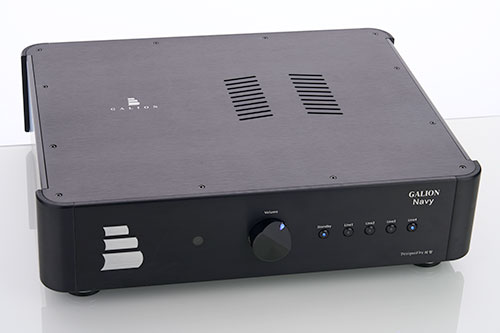With the Pagode Signature MK II, the German specialist for hi-fi racks, Finite Elemente GmbH, located in the North Rhine-Westphalian city of Paderborn, is offering a new line with a particularly attractive price-performance ratio for all those who don't want to compromise, but still want to keep their feet firmly on the ground in terms of price point. We took a close look at the E14 model.
Finite Elemente has made a name for themselves in the hi-fi scene thanks to its extremely sophisticated hi-fi rack solutions, which have been successfully established on the market for many years. For me personally, these products are a prime example of "Made in Germany" transported into the present day. So to say from the good old days, when this term still had a meaningful value in contrast to today. But hi-fi racks, hi-fi furniture or equipment bases, what is actually the right designation for these, well, "solutions" from Finite Elemente? As soon as you browse or scroll through the product pages, it becomes clear that these are not simply mundane "racks". Personally, I would even be inclined to speak affectionately of a "harbourage" for hi-fi components.
Following the Pagode Carbon Edition, Pagode Edition MK II and Pagode Master Reference MK II lines, Finite Elemente has now introduced the new Pagode Signature MK II range, which comprises also our review sample E14 at a price of 5,490 euros. This can certainly be understood as a friendly entry-level offer, because anyone reaching out for the Paderborn company's top lines mentioned at the beginning is prone to invest the equivalent of a well-equipped small car. Let’s then look at the keyword "Pagode": Each product line is preceded by this name. Wikipedia defines the English spelled “Pagoda” as follows (quote): "A pagoda is a distinctive, multi-storey, tower-like structure whose individual storeys are usually separated by projecting cornices or eaves." How appropriate!

But even those who are prepared to spend "only" five and a half thousand euros on four levels in order to position their hi-fi components on them will, on the one hand, put this amount in a reasonable relation to the price of their system and, on the other hand, expect decisive added value in terms of sonic performance. So, what does the buyer get? For such a price, you would actually have to grant a rack component status, but I wouldn't go quite that far yet. Or, should I actually have to? I'll defer this question for a while. Nevertheless, the purpose is to keep high-quality and sensitive hi-fi equipment, especially turntables and tube amplifiers, from being affected by impact noise and other annoying vibrations, so that the equipment can tap its full sonic potential. And this is precisely where Finite Elemente reaches deep into their bag of tricks, but first of all, the formalities.
-
Galion Audio Navy Röhrenvorverstärker
Wir haben das röhrenbestückte Vorverstärker-Flaggschiff Navy des jungen kanadischen HiFi-Unternehmens Galion Audio unter die Lupe genommen. Der Line-Vorverstärker mit vier Doppeltrioden 12AT7 (ECC81) wartet nicht nur mit hochwertigen Bauteilen auf, sondern er ist das spannende Designprodukt eines high-fidelen Überzeugungstäters. Mir sagte der Markenname Galion Audio bislang wirklich gar nichts. Das junge Unternehmen aus Québec in Kanada wurde 2020 von Thomas Tan, einem passionierten Audiophilen, YouTuber („Thomas & Stereo“) und Content Creator, gegründet. Ziel war, seine…16.12.2025 -
Eversolo DAC-Z10
Meine beiden D/A-Wandler, der DAVE im Arbeits- und der HUGO TT2 im Wohnzimmer, werden serienmäßig von Schaltnetzteilen gespeist. Bei letzterem kommt seit einiger Zeit ein Ferrum Hypsos, bei Chord Electronics Topmodell ein lineares Dreifach-Netzteil zum Einsatz. Ein solches versorgt auch den Eversolo DAC-Z10 – zum Preis von 2.000 Euro. Und nein, es sind keine drei ausgelagerten Stromversorgungen, für die der genannte Preis gilt. Dafür bekommt man das vollständige Topmodell unter Eversolos DACs. Es ist schon…09.12.2025 -
Raidho X2.6 Standlautsprecher
Mit Lautsprechern von Raidho haben wir uns bei Hifistatement schon öfter beschäftigt. Im Fokus standen dabei die Kompaktlautsprecher TD1.2 aus der TD-Serie sowie X1t und X1.6. aus der X-Serie. Diesmal haben wir den Standlautsprecher X2.6 zu Gast, das aktuell größte Modell der X-Serie. Raidho verspricht, mit der X-Serie besonders viel Leistung – sprich Klangqualität – für den aufgerufenen Preis zu bieten. Wobei, „billige“ Lautsprecher – ganz gleich nach welchem Maßstab - hat Raidho noch nie…02.12.2025 -
Canor Virtus A3
Zur diesjährigen HighEnd stellte Canor den Virtus A3 Hybrid-Vollverstärker vor. Der lockt mit einem integrierten Digital-Analog-Wandler und einer diskret aufgebauten Phono-Vorstufe für MM- und MC-Tonabnehmer. Sowohl seine Technik als auch die Ausstattung bieten Ungewöhnliches. Vor allem aber soll er klanglich beeindrucken. Das slowakische Entwickler-Team konnte mich bereits vor einem Jahr überzeugen: Der Vollverstärker Virtus I2 aus der Premium Line musizierte in meinem Hörraum wie keiner zuvor in dieser Preisklasse. Der war ein gestandener Röhren-Vollverstärker. Auch…28.11.2025 -
Dan D’Agostino Progression S350
Dan D’Agostino ist eine Legende im Verstärkerbau. Er folgte wohl nie einer Mode, sondern vertraut bei allen Entwicklungen seinem Gehör und seiner Leidenschaft für den guten Klang. Mehr als 50 Jahre baut er nun schon Verstärker, immer mit dem Ziel, das „Wesen der Musik hörbar zu machen“. Erfüllt auch der S350 diese hoch gesteckten Ambitionen? Die Progression S350 ist die kleinste Stereoendstufe im Gesamtprogramm. Optisch trägt sie alle charakteristischen Merkmale einer echten D’Agostino. Angefangen mit…25.11.2025 -
iFi Silent Power USB iPurifier Pro & Pulsar USB
Ohne iFis iDefender+ würde das PC-Audio-Setup in meinem Arbeitszimmer überhaupt nicht störungsfrei funktionieren. Dementsprechend ist es für mich eines der besten Tools im Bereich Computer-Audio. Der iPurifier Pro vereint seine Fähigkeiten mit denen eines iSilencer+ und noch mehr Features in einem Gehäuse. Außerdem teste ich das Pulsar USB-Kabel. iFi ist seit Jahren eine Konstante für hochqualitative Audio-Produkte zu fairen Preisen. Zuletzt wurde die Sparte für Stromversorgung, Kabel und Signal-Verbesserer unter SilentPower zusammengefasst. Noch bevor wir…21.11.2025
© 2025 | HIFISTATEMENT | netmagazine | Alle Rechte vorbehalten | Impressum | Datenschutz

























 |
|


















































































